上海交通大学:《英语读写》课程教学资源(PPT)rhetoric
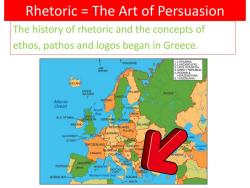
Rhetoric The Art of Persuasion The history of rhetoric and the concepts of ethos,pathos and logos began in Greece. SVALBARD 1.LITHUANIA 2.LUXEMBOUnG N 3.LIECHTENSTEIN 4.CZECH REPUBLIC 5.BOSNA& HERZEGOVINA B.YUGOBLAVIA CELAND RUSSIA Atlantic Ocean North Sea IS_E OF MAN- KINGDOM D日NIMA RAND BELAR POLAND GUEHNSEY JER3EY SWITZERLAND AUSTRIA HUNGARY ea FRANCE ANDORRA MARINC PORTUGAL SPAIN MONACO GIBRALTAR Mediterrsnean Sea ALBANIA MALTA
Rhetoric = The Art of Persuasion The history of rhetoric and the concepts of ethos, pathos and logos began in Greece

The School of Athens Painted by Raphael(1483-1520),this masterpiece depicts an intellectual gathering of the great philosophers of classical times at a school called the Ancient Agora of Athens.The Agora remains standing today in Athens, Greece.The school served as an academic meeting place for the great philosophers of classical times.In particular,this painting portrays Plato, Aristotle and other philosophers engaging in philosophical inquiry.Although this painting depicts Classical antiquity,it was created during the Renaissance
The School of Athens Painted by Raphael (1483-1520), this masterpiece depicts an intellectual gathering of the great philosophers of classical times at a school called the Ancient Agora of Athens. The Agora remains standing today in Athens, Greece. The school served as an academic meeting place for the great philosophers of classical times. In particular, this painting portrays Plato, Aristotle and other philosophers engaging in philosophical inquiry. Although this painting depicts Classical antiquity, it was created during the Renaissance
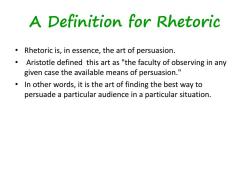
A Definition for Rhetoric Rhetoric is,in essence,the art of persuasion. Aristotle defined this art as "the faculty of observing in any given case the available means of persuasion." In other words,it is the art of finding the best way to persuade a particular audience in a particular situation
A Definition for Rhetoric • Rhetoric is, in essence, the art of persuasion. • Aristotle defined this art as "the faculty of observing in any given case the available means of persuasion." • In other words, it is the art of finding the best way to persuade a particular audience in a particular situation
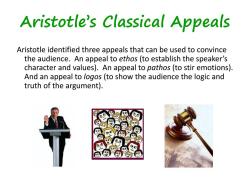
Aristotle's Classical Appeals Aristotle identified three appeals that can be used to convince the audience.An appeal to ethos(to establish the speaker's character and values).An appeal to pathos(to stir emotions). And an appeal to logos(to show the audience the logic and truth of the argument)
Aristotle’s Classical Appeals Aristotle identified three appeals that can be used to convince the audience. An appeal to ethos (to establish the speaker’s character and values). An appeal to pathos (to stir emotions). And an appeal to logos (to show the audience the logic and truth of the argument)
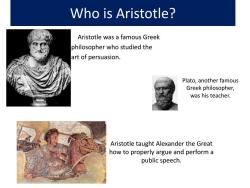
Who is Aristotle? Aristotle was a famous Greek philosopher who studied the art of persuasion. Plato,another famous Greek philosopher, was his teacher. Aristotle taught Alexander the Great how to properly argue and perform a public speech
Who is Aristotle? Aristotle was a famous Greek philosopher who studied the art of persuasion. Aristotle taught Alexander the Great how to properly argue and perform a public speech. Plato, another famous Greek philosopher, was his teacher
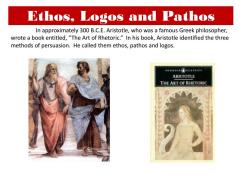
Ethos,Logos and Pathos In approximately 300 B.C.E.Aristotle,who was a famous Greek philosopher, wrote a book entitled,"The Art of Rhetoric."In his book,Aristotle identified the three methods of persuasion.He called them ethos,pathos and logos. FENGUINCEASNICS ARISTOTLE THE ART OF RHETORIC
Ethos, Logos and Pathos Aristotle Plato In approximately 300 B.C.E. Aristotle, who was a famous Greek philosopher, wrote a book entitled, “The Art of Rhetoric.” In his book, Aristotle identified the three methods of persuasion. He called them ethos, pathos and logos. The Man The Book

Ethos,Pathos and Logos 1. Ethos an ethical or moral argument 2. Pathos an emotional argument 3. Logos a logical argument
Ethos, Pathos and Logos 1. Ethos = an ethical or moral argument 2. Pathos = an emotional argument 3. Logos = a logical argument

Ethos The word "ethos"means moral or showing moral character.Aristotle contends that a speaker must establish moral credibility in the minds of the audience at the beginning of his or her speech.In order to do so,the speaker must show that he or she has expertise in the subject matter of the speech and that he or she is disconnected from topic (i.e.,the speaker does not and will not have a direct interest or an ulterior motive for convincing their audience). For example,when a trusted doctor gives you advice,you may not understand all of the medical reasoning behind the advice,but you nonetheless follow the directions because you believe that the doctor knows what s/he is talking about
Ethos The word "ethos“ means moral or showing moral character. Aristotle contends that a speaker must establish moral credibility in the minds of the audience at the beginning of his or her speech. In order to do so, the speaker must show that he or she has expertise in the subject matter of the speech and that he or she is disconnected from topic (i.e., the speaker does not and will not have a direct interest or an ulterior motive for convincing their audience). For example, when a trusted doctor gives you advice, you may not understand all of the medical reasoning behind the advice, but you nonetheless follow the directions because you believe that the doctor knows what s/he is talking about
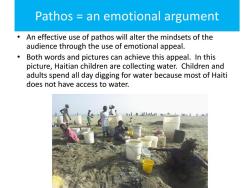
Pathos an emotional argument An effective use of pathos will alter the mindsets of the audience through the use of emotional appeal. Both words and pictures can achieve this appeal.In this picture,Haitian children are collecting water.Children and adults spend all day digging for water because most of Haiti does not have access to water
Pathos = an emotional argument • An effective use of pathos will alter the mindsets of the audience through the use of emotional appeal. • Both words and pictures can achieve this appeal. In this picture, Haitian children are collecting water. Children and adults spend all day digging for water because most of Haiti does not have access to water
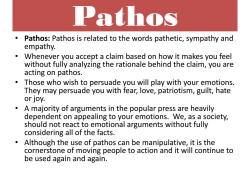
Pathos Pathos:Pathos is related to the words pathetic,sympathy and empathy. Whenever you accept a claim based on how it makes you feel without fully analyzing the rationale behind the claim,you are acting on pathos. Those who wish to persuade you will play with your emotions. They may persuade you with fear,love,patriotism,guilt,hate or joy. A majority of arguments in the popular press are heavily dependent on appealing to your emotions.We,as a society, should not react to emotional arguments without fully considering all of the facts. Although the use of pathos can be manipulative,it is the cornerstone of moving people to action and it will continue to be used again and again
Pathos • Pathos: Pathos is related to the words pathetic, sympathy and empathy. • Whenever you accept a claim based on how it makes you feel without fully analyzing the rationale behind the claim, you are acting on pathos. • Those who wish to persuade you will play with your emotions. They may persuade you with fear, love, patriotism, guilt, hate or joy. • A majority of arguments in the popular press are heavily dependent on appealing to your emotions. We, as a society, should not react to emotional arguments without fully considering all of the facts. • Although the use of pathos can be manipulative, it is the cornerstone of moving people to action and it will continue to be used again and again
按次数下载不扣除下载券;
注册用户24小时内重复下载只扣除一次;
顺序:VIP每日次数-->可用次数-->下载券;
- 上海交通大学:《英语读写》课程教学资源(PPT)political correctness.pptx
- 上海交通大学:《英语读写》课程教学资源(PPT)on various means.pptx
- 上海交通大学:《英语读写》课程教学资源(PPT)on seeing England for the first time.ppt
- 上海交通大学:《英语读写》课程教学资源(PPT)let them die.pptx
- 上海交通大学:《英语读写》课程教学资源(PPT)language.pptx
- 上海交通大学:《英语读写》课程教学资源(PPT)language and thought.pptx
- 上海交通大学:《英语读写》课程教学资源(PPT)Glorious Messiness of English.ppt
- 上海交通大学:《英语读写》课程教学资源(PPT)Generation X.pptx
- 上海交通大学:《英语读写》课程教学资源(PPT)Does America Still Exist.pptx
- 上海交通大学:《英语读写》课程教学资源(PPT)Canadians.pptx
- 上海交通大学:《英语读写》课程教学资源(PPT)beauty of Britain.pptx
- 上海交通大学:《汉字文化》教学资源_语苑荟萃_上海高校开展语言文字工作评估成效选编-市语委办市教育评估院-学林出版社-2017-3.pdf
- 上海交通大学:《汉字文化》教学资源(PPT讲义)试读几片甲骨.pptx
- 上海交通大学:《汉字文化》教学资源(PPT讲义)甲骨及甲骨学.pptx
- 上海交通大学:《汉字文化》教学资源(PPT讲义)汉字造字方法.pptx
- 上海交通大学:《汉字文化》教学资源(PPT讲义)汉字规范.pptx
- 上海交通大学:《汉字文化》教学资源(PPT讲义)汉字文化 课程说明.pptx
- 上海交通大学:《汉字文化》教学资源(PPT讲义)汉字文化 绪论.pptx
- 上海交通大学:《汉字文化》教学资源(PPT讲义)汉字与文字游戏.pptx
- 上海交通大学:《汉字文化》教学资源(PPT讲义)汉字与书法(新版本).pptx
- 上海交通大学:《英语读写》课程教学资源(PPT)why the rich are getting richer.pptx
- 上海交通大学:《莎士比亚戏剧赏析》课程教学资源_Antony and Cleopatra_Antony and Cleopatra.docx
- 上海交通大学:《莎士比亚戏剧赏析》课程教学资源_Antony and Cleopatra_Antony&Cleopatra-student.docx
- 上海交通大学:《莎士比亚戏剧赏析》课程教学资源_Antony and Cleopatra_安东尼与克莉奥佩特拉.docx
- 上海交通大学:《莎士比亚戏剧赏析》课程教学资源_Hamlet_Hamlet全文(英).doc
- 上海交通大学:《莎士比亚戏剧赏析》课程教学资源_Hamlet_哈姆雷特.doc
- 上海交通大学:《莎士比亚戏剧赏析》课程教学资源_KingLear_KingLear-class.docx
- 上海交通大学:《莎士比亚戏剧赏析》课程教学资源_KingLear_KingLear.docx
- 上海交通大学:《莎士比亚戏剧赏析》课程教学资源_KingLear_李尔王.docx
- 上海交通大学:《莎士比亚戏剧赏析》课程教学资源_Macbeth_Macbeth(in-class).doc
- 上海交通大学:《莎士比亚戏剧赏析》课程教学资源_Macbeth_Macbeth.doc
- 上海交通大学:《莎士比亚戏剧赏析》课程教学资源_Macbeth_麦克白.doc
- 上海交通大学:《莎士比亚戏剧赏析》课程教学资源_Merchant of V_Merchant of Venice.doc
- 上海交通大学:《莎士比亚戏剧赏析》课程教学资源_Merchant of V_威尼斯商人 students.doc
- 上海交通大学:《莎士比亚戏剧赏析》课程教学资源_Merchant of V_威尼斯商人.doc
- 上海交通大学:《莎士比亚戏剧赏析》课程教学资源_Midsummer N D_MidsummerNightDream(节选).doc
- 上海交通大学:《莎士比亚戏剧赏析》课程教学资源_Midsummer N D_Midsummernightsdream.doc
- 上海交通大学:《莎士比亚戏剧赏析》课程教学资源_Midsummer N D_仲夏夜之梦.doc
- 上海交通大学:《莎士比亚戏剧赏析》课程教学资源_Romeo and Juliet_R&J(in-class).doc
- 上海交通大学:《莎士比亚戏剧赏析》课程教学资源_Romeo and Juliet_Romeo and Juliet.doc
